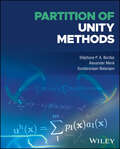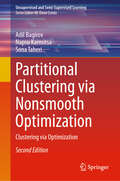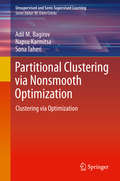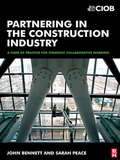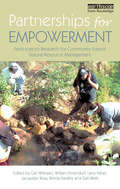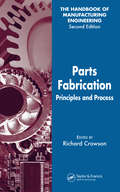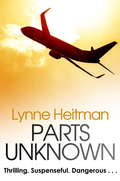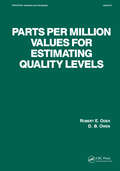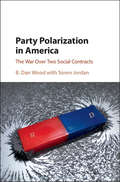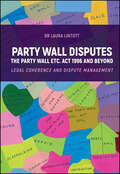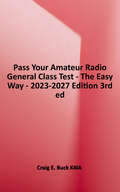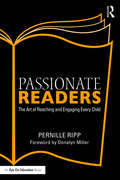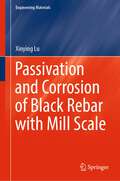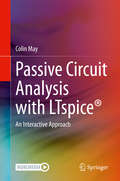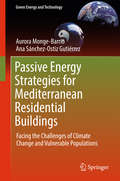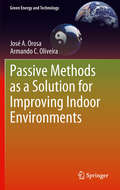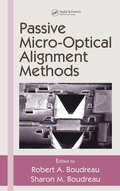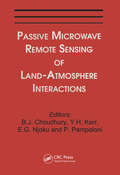- Table View
- List View
Partition of Unity Methods
by Stéphane P. Bordas Alexander Menk Sundararajan NatarajanPARTITION OF UNITY METHODS Master the latest tool in computational mechanics with this brand-new resource from distinguished leaders in the field While it is the number one tool for computer aided design and engineering, the finite element method (FEM) has difficulties with discontinuities, singularities, and moving boundaries. Partition of unity methods addresses these challenges and is now increasingly implemented in commercially available software. Partition of Unity Methods delivers a detailed overview of its fundamentals, in particular the extended finite element method for applications in solving moving boundary problems. The distinguished academics and authors introduce the XFEM as a natural extension of the traditional finite element method (FEM), through straightforward one-dimensional examples which form the basis for the subsequent introduction of higher dimensional problems. This book allows readers to fully understand and utilize XFEM just as it becomes ever more crucial to industry practice. Partition of Unity Methods explores all essential topics on this key new technology, including: Coverage of the difficulties faced by the finite element method and the impetus behind the development of XFEM The basics of the finite element method, with discussions of finite element formulation of linear elasticity and the calculation of the force vector An introduction to the fundamentals of enrichment A revisitation of the partition of unity enrichment A description of the geometry of enrichment features, with discussions of level sets for stationary interfaces Application of XFEM to bio-film, gradient theories, and three dimensional crack propagation Perfect for researchers and postdoctoral candidates working in the field of computational mechanics, Partition of Unity Methods also has a place in the libraries of senior undergraduate and graduate students working in the field. Finite element and CFD analysts and developers in private industry will also greatly benefit from this book.
Partitional Clustering via Nonsmooth Optimization: Clustering via Optimization (Unsupervised and Semi-Supervised Learning)
by Adil Bagirov Napsu Karmitsa Sona TaheriThis updated book describes optimization models of clustering problems and clustering algorithms based on optimization techniques, including their implementation, evaluation, and applications. The book gives a comprehensive and detailed description of optimization approaches for solving clustering problems; the authors' emphasis on clustering algorithms is based on deterministic methods of optimization. The book also includes results on real-time clustering algorithms based on optimization techniques, addresses implementation issues of these clustering algorithms, and discusses new challenges arising from very large data and data with noise and outliers. The book is ideal for anyone teaching or learning clustering algorithms. It provides an accessible introduction to the field and it is well suited for practitioners already familiar with the basics of optimization.
Partitional Clustering via Nonsmooth Optimization: Clustering via Optimization (Unsupervised and Semi-Supervised Learning)
by Napsu Karmitsa Sona Taheri Adil M. BagirovThis book describes optimization models of clustering problems and clustering algorithms based on optimization techniques, including their implementation, evaluation, and applications. The book gives a comprehensive and detailed description of optimization approaches for solving clustering problems; the authors' emphasis on clustering algorithms is based on deterministic methods of optimization. The book also includes results on real-time clustering algorithms based on optimization techniques, addresses implementation issues of these clustering algorithms, and discusses new challenges arising from big data. The book is ideal for anyone teaching or learning clustering algorithms. It provides an accessible introduction to the field and it is well suited for practitioners already familiar with the basics of optimization.
Partnering in the Construction Industry
by John Bennett Sarah PeacePartnering is the most effective way of tackling construction projects. This book explains how clients and construction firms using partnering can achieve ever higher levels of efficiency and certainty to provide world class buildings and infrastructure of all kinds.Detailed guidance about the actions that clients and professionals new to partnering need to take is given followed by advice about the actions individual firms can take to get the maximum benefits from partnering. Finally the book describes how highly developed forms of partnering are developing into strategic collaborative working that turns construction into a genuinely modern industry able to meet all customers’ needs. The book is designed to be used flexibly by a variety of readers, with coloured sections and executive summaries built into the body of the text to enable senior managers to get a quick overview of the guidance provided. The detailed guidance provides those at the workface with the ammunition needed to cooperate with those around them in doing their best work. The guidance is supported by check lists that help ensure everyone involved knows what they need to do to match and then exceed today’s best practice. Construction clients will learn how to get high quality, reliable and fast completion and a firm price that represents best value for money.This book helps everyone in the construction industry be fairly rewarded for delivering best practice. The expert guidance also gives the construction industry the time and resources needed to give proper attention to all aspects of quality including sustainability and total life cycle costs.to match and then exceed today’s best practice.
Partnerships for Empowerment: Participatory Research for Community-based Natural Resource Management
by Carl Wilmsen Larry Fisher Jacquelyn Ross Brinda Sarathy Gail Wells William ElmendorfParticipatory research has emerged as an approach to producing knowledge that is sufficiently grounded in local needs and realities to support community-based natural resource management (CBNRM), and it is often touted as crucial to the sustainable management of forests and other natural resources. This book analyses the current state of the art of participatory research in CBNRM. Its chapters and case studies examine recent experiences in collaborative forest management, harvesting impacts on forest shrubs, watershed restoration in Native American communities, civic environmentalism in an urban neighborhood and other topics. Although the main geographic focus of the book is the United States, the issues raised are synthesized and discussed in the context of recent critiques of participatory research and CBNRM worldwide. The book's purpose is to provide insights and lessons for academics and practitioners involved in CBNRM in many contexts. The issues it covers will be relevant to participatory research and CBNRM practitioners and students the world over.
Parts Fabrication: Principles and Process
by Richard CrowsonToday's fast-paced manufacturing culture demands a handbook that provides how-to, no-holds-barred, no-frills information. Completely revised and updated, the Handbook of Manufacturing Engineering is now presented in four volumes. Keeping the same general format as the first edition, this latest edition not only provides more information but makes i
Parts Unknown: A white-knuckle ride thriller set in the murky world of aviation
by Lynne HeitmanA gripping and fast-paced Alex Shanahan thriller set in the dangerous and murky world of aviation. Perfect for fans of Jeffery Deaver and James Patterson__________Alex Shanahan is on her way to a new job with a Detroit start-up airline when the death of a friend takes her on a detour to Miami. The trip turns deadly when Alex connects this murder to the lucrative world of black-market airplane parts: used parts that are illegally reworked, repainted and sold as new.Now Alex must walk into the darkest corner of the airline business she loves, the sordid underbelly of scavengers and chop shops, where profits are valued over the lives of a planeload of passengers - and murder isn't too far to go when millions are at stake.In a world where one faulty part can bring down an airliner and catastrophe is an acceptable risk, Alex must tread carefully, because every step she takes could be her last . . .__________Book 2 in the Alex Shanahan series.
Parts per Million Values for Estimating Quality Levels (Statistics: A Series of Textbooks and Monographs)
by R. E. OdehThis book is an extension of some tables from Odeh and Owen, Volume 32 of the Marcel Dekker, Inc., series Statistics: Textbooks and Monographs. The need for these tables was pointed out to us by Dr. James M. Maynard, who worked with the Parts Per Million Subcommittee.
Party Polarization in America: The War Over Two Social Contracts
by Wood Soren Jordan B. DanThis book develops a general explanation for party polarization in America from both historical and contemporary perspectives. Prior polarization studies focused exclusively on the modern era, but this work traces party polarization from the constitutional convention of 1787 to the present. Using such a broad historical perspective shows that what was unusual in American history was the period of low polarization from the Great Depression through 1980, rather than the period of high polarization of the modern era. Polarization is the norm of the American system, not the exception, and is likely to persist in the future. More theoretically, party polarization in America has been due to class-based conflict and rent-seeking by the patrician and plebian classes in various historical eras, rather than conflict over cultural values. As in earlier historical eras, modern party polarization has largely been elite-driven, with party entrepreneurs cunningly and strategically using polarization to their advantage.
Party Wall Disputes: The Party Wall etc. Act 1996 and Beyond - Legal Coherence, Disputes and Management
by Laura LintottAn accessible roadmap to the complexities of party wall disputes Party Wall Disputes: The Party Wall etc. Act 1996 and Beyond - Legal Coherence and Dispute Management meets the need for a roadmap to the main areas of law and fact relevant to party wall disputes: Statutes, including a detailed analysis of the Party Wall etc. Act 1996 and other relevant legislation,Property rights, such as rights of way, rights of support, drainage rights and rights linked to easements,Torts, such as nuisance related to noise and vibration and breaches of rights to light, andFactual matters, such as structural issues. In addition, this book maps out the available dispute management options under the Party Wall etc. Act 1996, in court as well as alternative dispute resolution methods (arbitration, mediation, medi-arb, expert determination and early neutral evaluation). The result is an invaluable resource for lawyers, party wall surveyors, construction professionals, academics and property owners who encounter or are interested in party wall disputes. “I can say with confidence that Dr Lintott has done the professions both of the law and of surveying in particular, as well as property owners, a great service in providing something of a stocktake…, where the tectonic plates of title, use of land, statute and common law, easements, planning and construction codes, rights, liabilities and obligations all meet. … She is mindful of the reality that party wall practice is ultimately driven by mutual proprietorial and essentially practical considerations …” —THE EARL OF LYTTON
Pass Your Amateur Radio General Class Test - The Easy Way 2023-2027 Edition
by Craig E. BuckUpdated with December 2023 changes. FOR TESTS AFTER JULY 1, 2023. This is the third edition of the popular All Ham and No Spam® General Class license manual. Other study guides include three wrong multiple-choice answers for every question. You have to slog through over 1,000 wrong answers! That is Spam! The Easy Way is a concise explanation of every question with only the correct answers, hints and cheats to help you remember. The right answers will jump out when you take the test. The wrong answers will look strange because you have never seen them. Don't waste your time on Spam! Previous editions have received thousands of 5-star reviews. Get your General Class license The Easy Way.
Passenger Car Tires and Wheels: Development - Manufacturing - Application
by Günter LeisterStarting from the beginning, this book explains the development process of all parts related to the topics tire, wheel and tire pressure monitoring system. This is continued by the modern project management methods in the development process of the parts and the necessary tests to build up this safety relevant components. Modern methods for simulations are described.
Passenger List: The tie-in novel to the award-winning, cult-hit podcast
by John DrydenA missing plane.A cabin full of suspects.One woman's quest for the truth.When Atlantic Airlines Flight 702 disappears mid-flight between London and New York, the world is stunned. With the public clamouring for answers, authorities seem at a loss as to how to explain the plane's disappearance. There were 256 passengers on Flight 702, with many carrying dark secrets on board with them. Could one of them hold the truth behind the plane's disappearance? College student Kaitlin Le's beloved twin brother Conor was on that plane. She refuses to believe the official statements, or to join her parents in their blind acceptance of Conor's death. But as she journeys deeper into the murky heart of what really happened on board that plane, it becomes clear she's drawing attention to herself. And there are some people who would rather the truth behind the fate of Flight 702 stayed buried...
Passenger List: The tie-in novel to the award-winning, cult-hit podcast
by John Dryden'A first class, edge-of-your-seat thriller. Fast-paced, flawlessly executed and hugely entertaining, it'll leave you breathless.' Sara LotzA missing plane.A cabin full of suspects.One woman's quest for the truth.When Atlantic Airlines Flight 702 disappears mid-flight between London and New York, the world is stunned. With the public clamouring for answers, authorities seem at a loss as to how to explain the plane's disappearance. There were 256 passengers on Flight 702, with many carrying dark secrets on board with them. Could one of them hold the truth behind the plane's disappearance? College student Kaitlin Le's beloved twin brother Conor was on that plane. She refuses to believe the official statements, or to join her parents in their blind acceptance of Conor's death. But as she journeys deeper into the murky heart of what really happened on board that plane, it becomes clear she's drawing attention to herself. And there are some people who would rather the truth behind the fate of Flight 702 stayed buried...
Passing Strange: A Gilded Age Tale of Love and Deception Across the Color Line
by Martha A. Sandweiss"Passing Strange" is a uniquely American biography of Clarence King, who hid a secret from his Gilded Age cohorts and prominent family: for 13 years he lived a double life--as the celebrated white explorer, geologist, and writer King and as a black Pullman porter and steelworker named James Todd.
Passionate Readers: The Art of Reaching and Engaging Every Child
by Pernille RippHow do we inspire students to love reading and discovery? In Passionate Readers: The Art of Reaching and Engaging Every Child, classroom teacher, author, and speaker Pernille Ripp reveals the five keys to creating a passionate reading environment. You’ll learn how to… Use your own reading identity to create powerful reading experiences for all students Empower your students and their reading experience by focusing on your physical classroom environment Create and maintain an enticing, well-organized, easy-to-use classroom library; Build a learning community filled with choice and student ownership; and Guide students to further develop their own reading identity to cement them as life-long, invested readers. Throughout the book, Pernille opens up about her own trials and errors as a teacher and what she’s learned along the way. She also shares a wide variety of practical tools that you can use in your own classroom, including a reader profile sheet, conferring sheet, classroom library letter to parents, and much more. These tools are available in the book and as eResources to help you build your own classroom of passionate readers.
Passivation and Corrosion of Black Rebar with Mill Scale (Engineering Materials)
by Xinying LuThe passivation and corrosion of metal are significantly affected by its surface state and chemical characteristics. In practical engineering, the reinforcement is with mill scale or rust stains. Its passivation and corrosion are obviously different from the descaled one. This book briefly discusses the pseudo-passivation behavior and corrosion mechanisms of hot-rolled rebars with mill scale and provides the corresponding protection measures, which can be used as a reference for corrosion or civil engineers.
Passive Circuit Analysis with LTspice®: An Interactive Approach
by Colin MayThis book shows readers how to learn analog electronics by simulating circuits. Readers will be enabled to master basic electric circuit analysis, as an essential component of their professional education. The author’s approach enables readers to learn theory as needed, then immediately apply it to the simulation of circuits based on that theory, while using the resulting tables, graphs and waveforms to gain a deeper insight into the theory, as well as where theory and practice diverge!
Passive Energy Strategies for Mediterranean Residential Buildings
by Aurora Monge-Barrio Ana Sánchez-Ostiz GutiérrezThis book presents an approach to energy-efficient building design, which takes into account the most important challenges in climate change mitigation and adaptation in Southern Europe. It outlines a specific approach related to residential buildings and their intergenerational and vulnerable occupants, such as ageing population and users in fuel poverty. It also focuses on the use of passive energy measures throughout the year, and on pursuing a realistic and affordable approach to the efficient rehabilitation of resilient residential buildings.In addition, the book presents case studies that include surveys, monitoring, and simulation of residential buildings in Spain and other Southern European representative locations, in order to go further on the study of this challenging topic.
Passive Imaging With Ambient Noise
by Josselin Garnier George PapanicolaouWaves generated by opportunistic or ambient noise sources and recorded by passive sensor arrays can be used to image the medium through which they travel. Spectacular results have been obtained in seismic interferometry, which open up new perspectives in acoustics, electromagnetics, and optics. The authors present, for the first time in book form, a self-contained and unified account of correlation-based and ambient noise imaging. In order to facilitate understanding of the core material, they also address a number of related topics in conventional sensor array imaging, wave propagation in random media, and high-frequency asymptotics for wave propagation. Taking a multidisciplinary approach, the book uses mathematical tools from probability, partial differential equations and asymptotic analysis, combined with the physics of wave propagation and modelling of imaging modalities. Suitable for applied mathematicians and geophysicists, it is also accessible to graduate students in applied mathematics, physics, and engineering.
Passive Intermodulation: Concepts and Technology (Space Science, Technology and Application Series)
by Wanzhao CuiFocusing on passive intermodulation (PIM), a common instance of distortion in high-power multi-channel communication systems, the book introduces the concepts and technology of PIM.In the context of "space-ground-object" integrated communication and increasing spectrum resource constraints, the PIM problem is becoming increasingly prominent, while microwave components and system-level PIM are facing new challenges. Based on the experience and achievements in engineering practice of the China Academy of Space Technology in Xi’an, this title describes the basic theory, generation mechanism, analysis and evaluation methods, location detection and suppression techniques for microwave components of spacecraft PIM from a theoretical and engineering perspective. Furthermore, the latest achievements of microwave component PIM are outlined in depth, along with operational guidance and paths for further advancement.This book will be a useful reference for researchers, engineers and students interested in microwave technology, satellite technology and mobile communication technology. Wanzhao Cui is a professor at the National key Laboratory of Science and Technology on Space Microwave, at the China Academy of Space Technology, Xi’an, China. His current research interests include microwave technology and satellite communication. Jun Li is a professor at the National key Laboratory of Science and Technology on Space Microwave, at the China Academy of Space Technology, Xi’an, China. He is engaged in research on microwave technology and satellite communication. Huan Wei is a senior engineer at the National key Laboratory of Science and Technology on Space Microwave, at the China Academy of Space Technology, Xi’an, China. Her expertise is in the field of space microwave technology. Xiang Chen is a senior engineer at the National Key Laboratory of Science and Technology on Space Microwave, at the China Academy of Space Technology, Xi’an, China. His research interests are microwave and millimeter wave technology.
Passive Macromodeling
by Stefano Grivet-Talocia Bjorn GustavsenOffers an overview of state of the art passive macromodeling techniques with an emphasis on black-box approachesThis book offers coverage of developments in linear macromodeling, with a focus on effective, proven methods. After starting with a definition of the fundamental properties that must characterize models of physical systems, the authors discuss several prominent passive macromodeling algorithms for lumped and distributed systems and compare them under accuracy, efficiency, and robustness standpoints. The book includes chapters with standard background material (such as linear time-invariant circuits and systems, basic discretization of field equations, state-space systems), as well as appendices collecting basic facts from linear algebra, optimization templates, and signals and transforms. The text also covers more technical and advanced topics, intended for the specialist, which may be skipped at first reading. Provides coverage of black-box passive macromodeling, an approach developed by the authors Elaborates on main concepts and results in a mathematically precise way using easy-to-understand language Illustrates macromodeling concepts through dedicated examples Includes a comprehensive set of end-of-chapter problems and exercises Passive Macromodeling: Theory and Applications serves as a reference for senior or graduate level courses in electrical engineering programs, and to engineers in the fields of numerical modeling, simulation, design, and optimization of electrical/electronic systems.Stefano Grivet-Talocia, PhD, is an Associate Professor of Circuit Theory at the Politecnico di Torino in Turin, Italy, and President of IdemWorks. Dr. Grivet-Talocia is author of over 150 technical papers published in international journals and conference proceedings. He invented several algorithms in the area of passive macromodeling, making them available through IdemWorks.Bjørn Gustavsen, PhD, is a Chief Research Scientist in Energy Systems at SINTEF Energy Research in Trondheim, Norway. More than ten years ago, Dr. Gustavsen developed the original version of the vector fitting method with Prof. Semlyen at the University of Toronto. The vector fitting method is one of the most widespread approaches for model extraction. Dr. Gustavsen is also an IEEE fellow.
Passive Methods as a Solution for Improving Indoor Environments
by José A. Orosa Armando C. OliveiraThere are many aspects to consider when evaluating or improving an indoor environment; thermal comfort, energy saving, preservation of materials, hygiene and health are all key aspects which can be improved by passive methods of environmental control. Passive Methods as a Solution for Improving Indoor Environments endeavours to fill the lack of analysis in this area by using over ten years of research to illustrate the effects of methods such as thermal inertia and permeable coverings; for example, the use of permeable coverings is a well known passive method, but its effects and ways to improve indoor environments have been rarely analyzed. Passive Methods as a Solution for Improving Indoor Environments includes both software simulations and laboratory and field studies. Through these, the main parameters that characterize the behavior of internal coverings are defined. Furthermore, a new procedure is explained in depth which can be used to identify the real expected effects of permeable coverings such as energy conservation and local thermal comfort as well as their working periods in controlling indoor environments. This theoretical base is built on by considering future research work including patents and construction indications which will improve indoor environmental conditions with evidence from real data. This makes Passive Methods as a Solution for Improving Indoor Environments an ideal resource for specialists and researchers focusing on indoor air quality, thermal comfort, and energy saving or with a general interest in controlling indoor environments with passive methods.
Passive Micro-Optical Alignment Methods
by Robert A. Boudreau Sharon M. BoudreauThe most expensive phase in the manufacture of micro-optical components and fiber optics is also one of the most performance-critical: optical alignment of the components. The increasing degree of miniaturization makes this an especially challenging task. Active alignment methods result in higher costs and awkward processes, and for some applications, they simply are not possible. Passive Micro-Optical Alignment Methods introduces the passive alignment methods that are currently available and illustrates them with many examples, references, and critiques.The first book dedicated to passive alignment, it begins with an overview of the current activities, requirements, and general results of passive optical alignments, followed by three sections of in-depth analysis. The first of these discusses mechanical passive alignment, highlighting silicon waferboard, solder, and "Jitney" technologies as well as application of mechanical alignment to 3D free-space interconnects. The next section describes the various visual alignment techniques applied to Planar Lightwave Circuits (PLCs) and low-cost plastic and surface mount packaging. The final section details various utilities that aid passive alignment and their resulting tradeoffs and demonstrates Monte Carlo analysis to evaluate the potential of a given method.Passive Micro-Optical Alignment Methods provides the tools necessary to meet the challenge of precision and low-cost alignment for applications that require micron or sub-micron tolerance.
Passive Microwave Remote Sensing of Land--Atmosphere Interactions
by B. J. Choudhury Y. H. Kerr E. G. Njoku P. PampaloniRecent advances in theory and observations using passive microwave remote sensing have hightlighted the potential of spaceborne sensors for contributing to the required land surface measurements of soils, vegetation, snow cover and precipitation. Furthermore, the spatial resolution of passive microwave observations matches the special scales of large-scale models of land-atmosphere interactions both for data assimilation and validation. In order to stimulate and focus this research a workshop, sponsored by ESA and NASA, was organized to review the state-of-the-art in microwave radiometry related to land applications and to exchange ideas leading into new directions for future research. This volume contains the refereed papers from the aforementioned ESA/NASA workshop, which are arranged by topic, as well as the (edited) working group reports.
